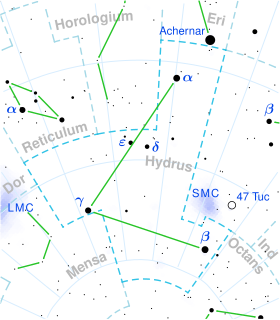Epsilon Hydri
| Observation data Epoch J2000 Equinox J2000 | |
|---|---|
| Constellation | Hydrus |
| Right ascension | 02h 39m 35.36121s[1] |
| Declination | −68° 16′ 01.0103″[1] |
| Apparent magnitude (V) | 4.12[2] |
| Characteristics | |
| Spectral type | B9 Va[2] |
| U−B color index | −0.14[3] |
| B−V color index | −0.06[3] |
| Astrometry | |
| Radial velocity (Rv) | +13.6±0.9[4] km/s |
| Proper motion (μ) | RA: +87.30[1] mas/yr Dec.: +0.09[1] mas/yr |
| Parallax (π) | 21.48 ± 0.09 mas[1] |
| Distance | 151.8 ± 0.6 ly (46.6 ± 0.2 pc) |
| Absolute magnitude (MV) | +0.78[2] |
| Details | |
| Mass | 2.64[5] M☉ |
| Radius | 2.2[6] R☉ |
| Luminosity | 60[5] L☉ |
| Surface gravity (log g) | 4.33[7] cgs |
| Temperature | 10,970±373[7] K |
| Rotational velocity (v sin i) | 96[5] km/s |
| Age | 133[7] Myr |
| Other designations | |
| Database references | |
| SIMBAD | data |
Epsilon Hydri, Latinized from ε Hydri, is a single,[8] blue-white hued star in the southern constellation of Hydrus. It is a faint star with an apparent visual magnitude of 4.12,[2] but it can be seen with the naked eye. Measurements made by the Hipparcos spacecraft showed an annual parallax shift of 21.48 mas,[1] which provides a distance estimate of 152 light years. The star is moving away from the Sun with a radial velocity of +13.6 km/s.[4] It is a member of the Tucana-Horologium moving group, an association of stars that share a common motion through space.[9]
The stellar classification for this star is B9 Va,[2] indicating that is it a B-type main-sequence star that is generating energy through hydrogen fusion at its core. It is a young star, just 133[7] million years in age, and has a high rate of spin with a projected rotational velocity of 96 km/s.[5] This is giving the star a mild oblate shape with an equatorial bulge that is 5% greater than the polar radius.[10] Epsilon Hydri has an estimated 2.64 times the mass of the Sun and 2.2 times the Sun's radius.[5] It is radiating 60[5] times the Sun's luminosity from its photosphere at an effective temperature of around 10,970 K.[7]
References
[edit]- ^ a b c d e f Van Leeuwen, F. (2007). "Validation of the new Hipparcos reduction". Astronomy and Astrophysics. 474 (2): 653–664. arXiv:0708.1752. Bibcode:2007A&A...474..653V. doi:10.1051/0004-6361:20078357. S2CID 18759600. Vizier catalog entry
- ^ a b c d e Anderson, E.; Francis, Ch. (2012). "XHIP: An extended hipparcos compilation". Astronomy Letters. 38 (5): 331. arXiv:1108.4971. Bibcode:2012AstL...38..331A. doi:10.1134/S1063773712050015. S2CID 119257644. Vizier catalog entry
- ^ a b Mallama, A. (2014). "Sloan Magnitudes for the Brightest Stars". The Journal of the American Association of Variable Star Observers. 42 (2): 443. Bibcode:2014JAVSO..42..443M.Vizier catalog entry
- ^ a b Gontcharov, G. A. (2006). "Pulkovo Compilation of Radial Velocities for 35 495 Hipparcos stars in a common system". Astronomy Letters. 32 (11): 759–771. arXiv:1606.08053. Bibcode:2006AstL...32..759G. doi:10.1134/S1063773706110065. S2CID 119231169.
- ^ a b c d e f Zorec, J.; Royer, F. (2012). "Rotational velocities of A-type stars". Astronomy & Astrophysics. 537: A120. arXiv:1201.2052. Bibcode:2012A&A...537A.120Z. doi:10.1051/0004-6361/201117691. S2CID 55586789. Vizier catalog entry
- ^ Allende Prieto, C.; Lambert, D. L. (1999). "Fundamental parameters of nearby stars from the comparison with evolutionary calculations: Masses, radii and effective temperatures". Astronomy and Astrophysics. 352: 555–562. arXiv:astro-ph/9911002. Bibcode:1999A&A...352..555A. Vizier catalog entry
- ^ a b c d e David, Trevor J.; Hillenbrand, Lynne A. (2015). "The Ages of Early-Type Stars: Strömgren Photometric Methods Calibrated, Validated, Tested, and Applied to Hosts and Prospective Hosts of Directly Imaged Exoplanets". The Astrophysical Journal. 804 (2): 146. arXiv:1501.03154. Bibcode:2015ApJ...804..146D. doi:10.1088/0004-637X/804/2/146. S2CID 33401607. Vizier catalog entry
- ^ Eggleton, P. P.; Tokovinin, A. A. (September 2008), "A catalogue of multiplicity among bright stellar systems", Monthly Notices of the Royal Astronomical Society, 389 (2): 869–879, arXiv:0806.2878, Bibcode:2008MNRAS.389..869E, doi:10.1111/j.1365-2966.2008.13596.x, S2CID 14878976.
- ^ Bell, Cameron P. M.; et al. (November 2015), "A self-consistent, absolute isochronal age scale for young moving groups in the solar neighbourhood", Monthly Notices of the Royal Astronomical Society, 454 (1): 593–614, arXiv:1508.05955, Bibcode:2015MNRAS.454..593B, doi:10.1093/mnras/stv1981
- ^ Belle, G. T. (2012). "Interferometric observations of rapidly rotating stars". The Astronomy and Astrophysics Review. 20 (1): 51. arXiv:1204.2572. Bibcode:2012A&ARv..20...51V. doi:10.1007/s00159-012-0051-2. S2CID 119273474.

